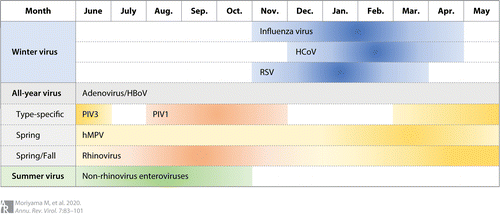To explore more Coffee Conversations with Scientists episodes, click here.
Each year, the winter months arrive and bring a symphony of coughs, sneezes, and sniffles you can hear just about anywhere. Respiratory illness season happens every year, and yet winter 2022/2023 saw earlier and greater numbers of influenza (flu) and respiratory cyncytial cirus (RSV) infections, in addition to continuing cases of COVID-19.
Why does respiratory illness season happen every year, and why was this year so bad? And, as you try to stay healthy and avoid catching these annually cycling viruses, what can you do to protect yourself and your community?
In an episode of Coffee Conversations with Scientists, John Meurer, MD, MBA, professor of pediatrics and community health at the Medical College of Wisconsin, discussed how seasonal respiratory illnesses are transmitted among communities and what you can do to support your health.
What Are Seasonal Respiratory Illnesses?
According to Dr. Meurer, “Seasonal respiratory illnesses are viral infections, like influenza, RSV, and COVID-19. They’re most common in the colder winter months when people are hunkered down indoors more often. Because we’re indoors with less ventilation and closer together, it’s easier to spread those infections… all of them cause a runny nose, congestion, sore throat, and a cough.”
In addition to the “winter viruses” mentioned above, other respiratory viruses emerge at different times of the year. In the spring and fall, rhinovirus infections (common colds) are at a high. Non-rhinovirus enteroviruses (such as hand, foot, and mouth disease) tend to spread in the summer.
Studies suggest that the seasonality of respiratory viruses is due to annual changes in temperature, sunlight, vitamin status, and human behavior, all of which might influence a virus’ spread. Interestingly, the observed seasonal cycle of respiratory illnesses in human populations dates back to ancient Greece!

Seasonal respiratory virus infections calendar
How Do Viruses Spread During Respiratory Illness Season?
There’s some truth to the adage that you’ll catch a cold if you spend time outside without a hat or coat in the winter. However, spending time outdoors isn’t the primary cause of the spread.
As Dr. Meurer explained, “RSV, influenza, and COVID-19 are all very contagious. They’re spread through coughing and sneezing the respiratory droplets in the air. That’s why wearing a mask reduces our breathing that in, and wearing a mask prevents it from spreading to others… Being in a well-ventilated, open space is good, so really crowded spaces with poor ventilation are a greater risk for people to acquire those respiratory infections.”
Why Has This Season Been Worse Than Usual for Seasonal Respiratory Illnesses?
Seasonal respiratory illnesses arise annually, but there were record levels of hospitalizations for flu and RSV this year. Some seasonal viruses also appeared earlier than usual. The Centers for Disease Control and Prevention (CDC) reported that flu season began about a month early, and RSV began circulating in the late summer instead of winter.
Why is this respiratory illness season different? For starters, the first two years of the pandemic saw people limiting contact, wearing masks, and social distancing. These measures limited the transmission of the flu’s spread. Similarly, the typical spread of RSV during that time was stalled. As fewer children and adults contracted the seasonal viruses in recent years, they were more susceptible this season.
Dr. Meurer said, “If you think back to 2020, folks were isolated, not going out and uncertain, and wearing masks was more common. As folks have felt more comfortable with vaccine protection, having had the infection, and becoming familiar with how to be safe, we see fewer masks in public places than we did one or two years ago. As a consequence, these seasonal respiratory viruses are more easily spread as we feel more comfortable.”
How to Stay Healthy This Respiratory Illness Season
To stay healthy and minimize the possibility of getting seasonal respiratory viruses, the CDC recommends covering coughs and sneezes, washing hands often, avoiding close contact with others, and cleaning frequently touched surfaces.
Dr. Meurer suggests, “When you happen to get an infection, coughing and sneezing in your sleeve and washing your hands is incredibly effective at preventing the spread. If there’s a vulnerable person around, wearing a mask and being safe about the place you might go. And, seriously considering the vaccines for COVID-19 and influenza.”
Dr. Meurer also recommended locating current virus prevalence where you live or where you might be traveling so that you can plan your activities accordingly. CDC’s Know Your COVID-19 Community Level tool can be used to locate information about community spread levels and guidance on preventing further spread. The agency also provides a tool for tracking flu cases. The information these sites offer can be used to understand the relative risks of these respiratory illnesses and make your safety decisions.
To hear more from Dr. Meurer about the science behind seasonal respiratory illness, watch the Coffee Conversations with Scientists episode here:




